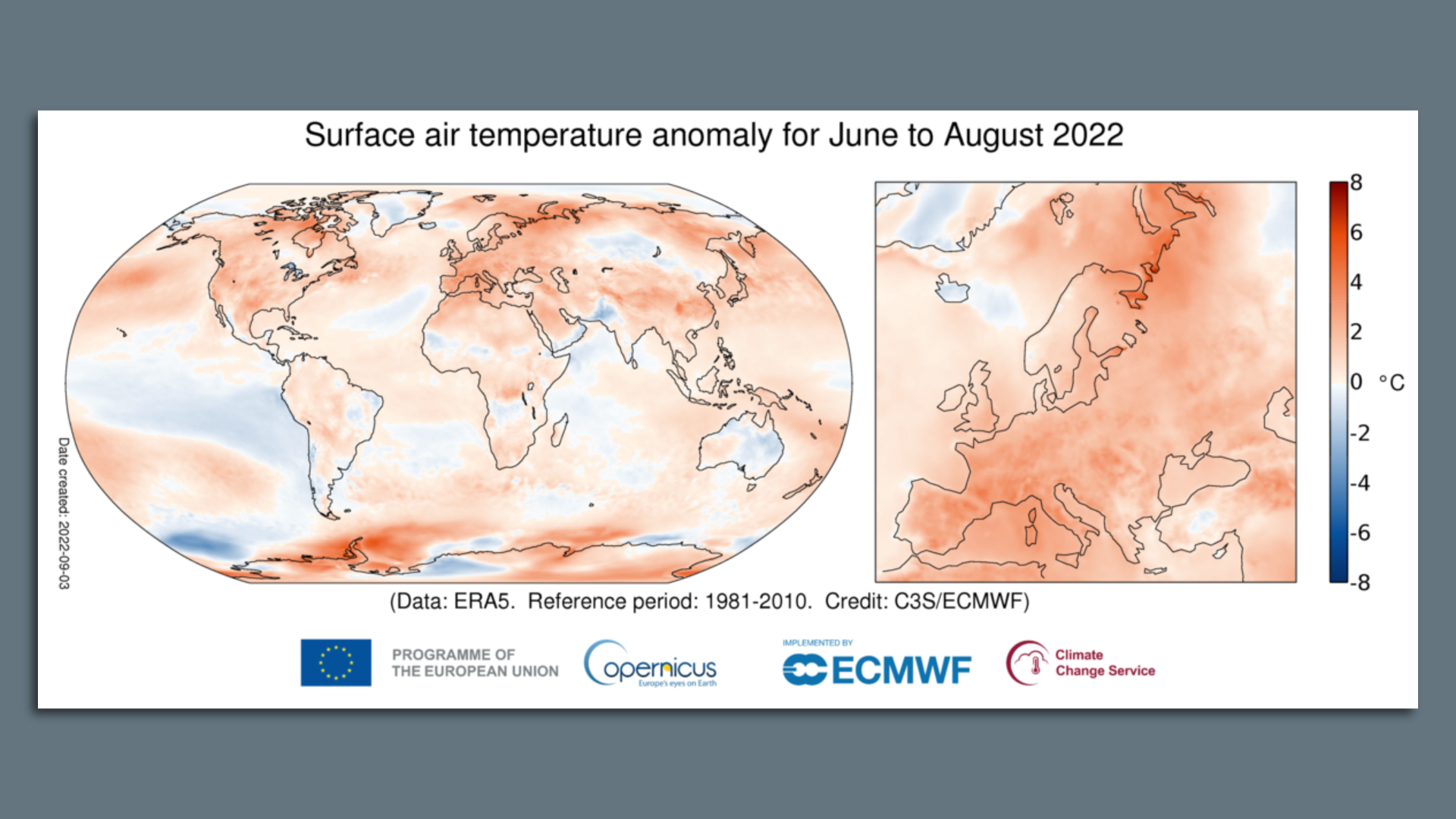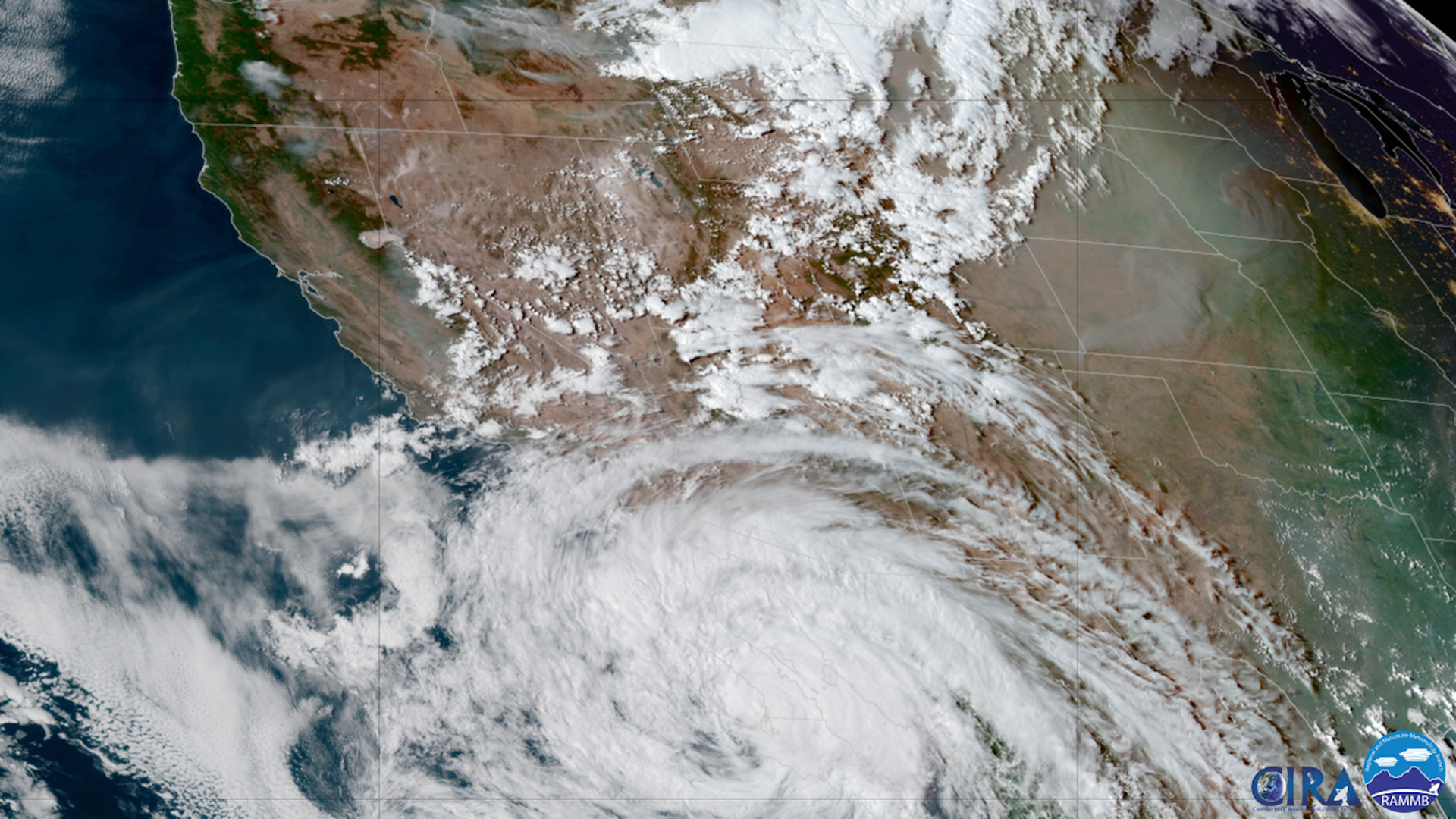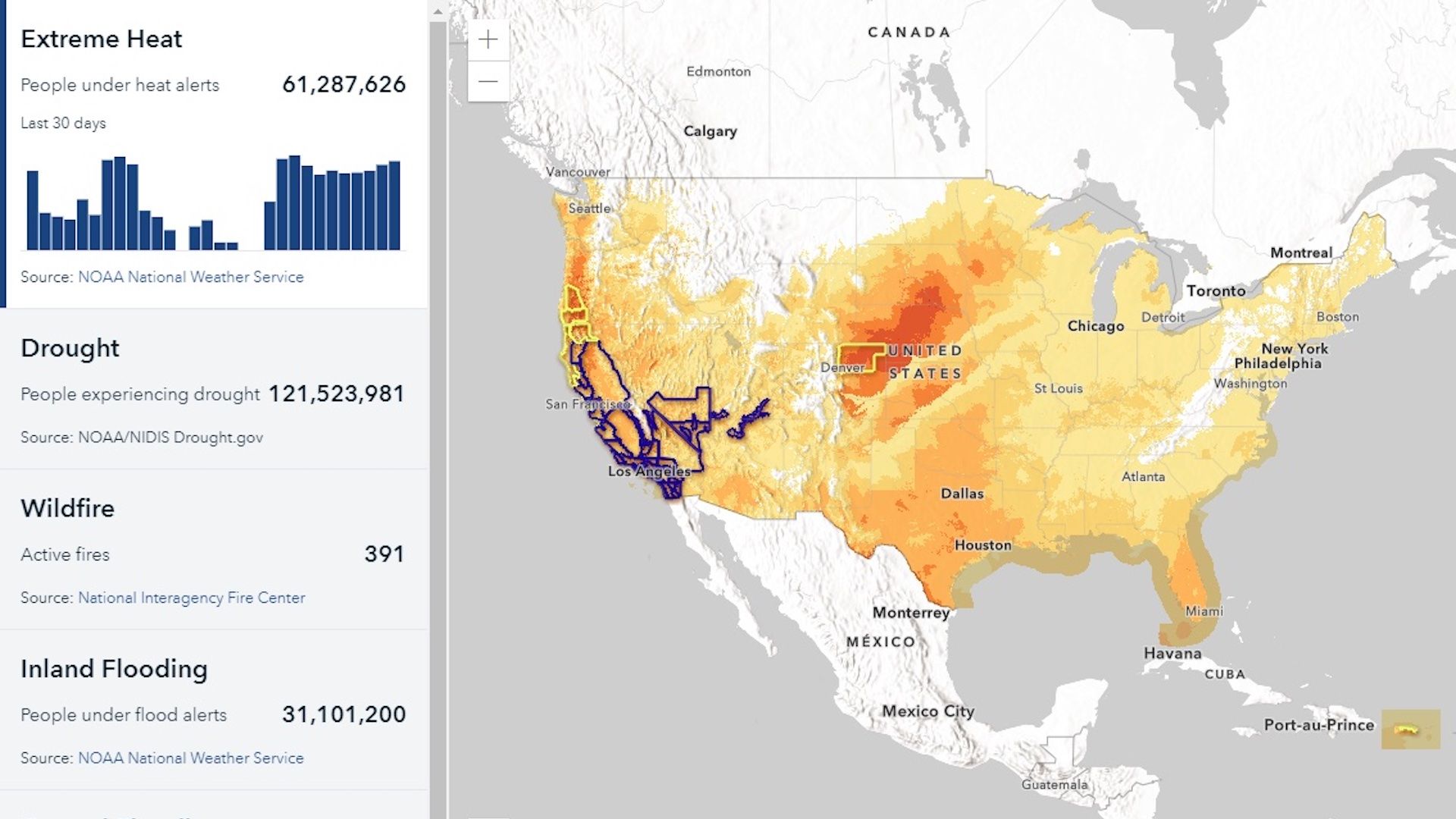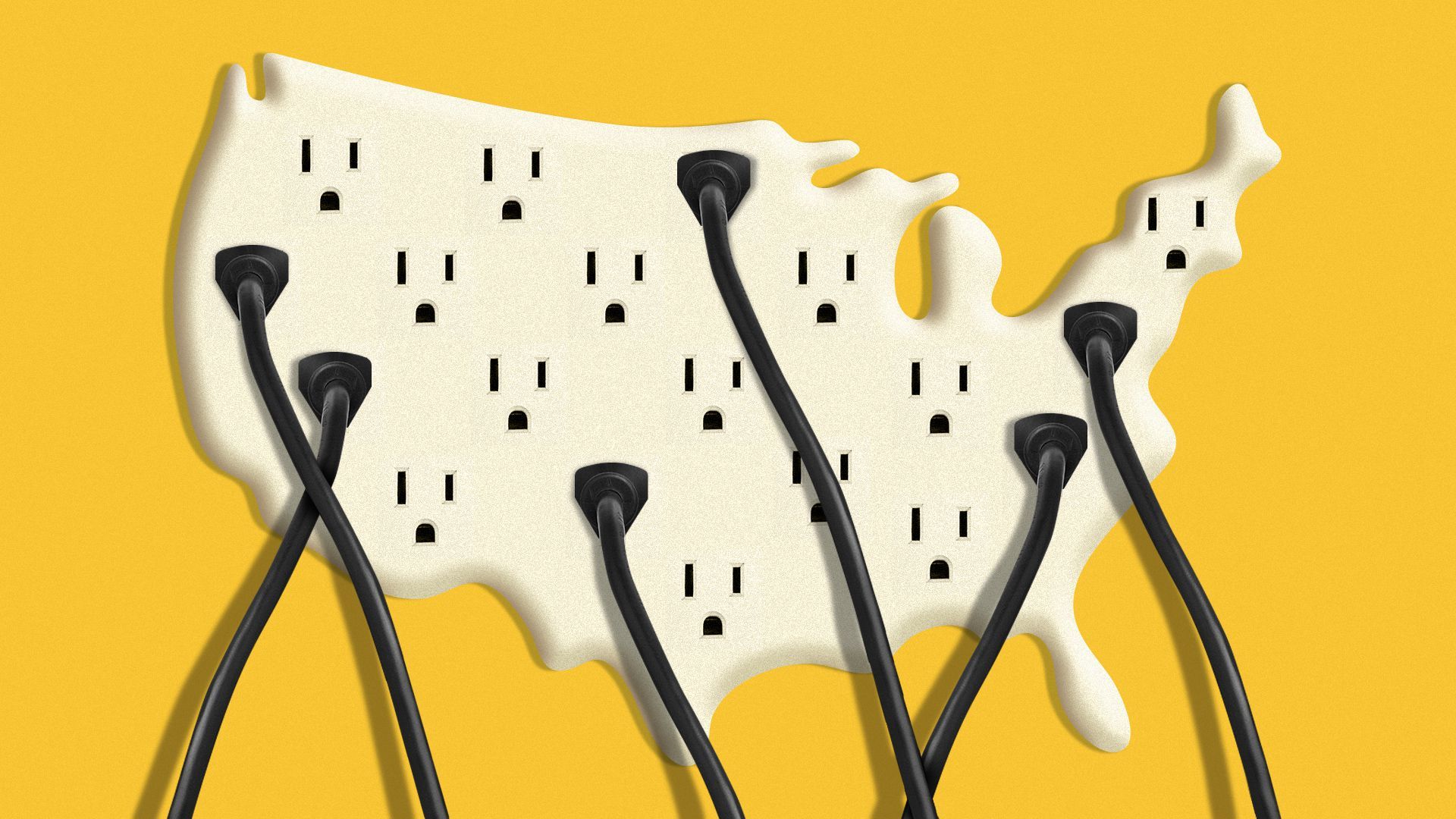| | | | | | | | | | | Axios Generate | | By Ben Geman and Andrew Freedman · Sep 09, 2022 | | 🍺 Made it! Friday. Today's newsletter has a Smart Brevity count of 1,249 words, 5 minutes. 📬 Did a friend send you this newsletter? Welcome, please sign up. 🎶 Happy birthday to the late soul legend Otis Redding, who has this week's final intro tune... | | | | | | 1 big thing: Europe's hottest summer |  | | | Image courtesy of Copernicus Climate Change Service | | | | Europeans just suffered through their hottest summer on record, according to new data from the Copernicus Climate Change Service, Andrew writes. - Temperatures came in 0.4°C (0.72°F) above the previous record-holder, which was way back in... 2021.
Why it matters: The record is another indication of how climate change is rapidly altering the summer season across the Northern Hemisphere. Driving the news: The extreme weather events this summer across Europe included several extraordinary heat waves. The big picture: According to Copernicus, an EU scientific program, Europe's average temperature for the season was 1.34°C (2.41°F) above the 1991-2020 average. - Europe also had its hottest August on record by far, with temperatures of 1.72°C (3.1°F) above the 1991-2020 average, which was 0.8°C (1.44°F) above the previous record-holder.
- The unusual European warmth led to a dramatic acceleration in the melt rate of European glaciers, leading one scientific team to deploy new instruments to keep a long-running data set intact.
By the numbers: Heat waves also affected Scandinavia, where the temperature hit 90.5°F (32.5°C) in far northern Norway in late June. - In England, 46 locations met or beat the country's previous all-time record high of 101.6°F (38.7°C) on July 18 and 19, and exceeded 104°F (40°C) for the first time.
- Overall, England tied for its hottest summer on record, according to Copernicus.
- France, which saw large wildfires, had its second-hottest summer on record, coming in behind 2003.
- However, the number of heat wave days in 2022 outranked that of 2003, which is significant considering an extreme heat event in 2003 killed up to 70,000 people.
The intrigue: A climate attribution study on the U.K. heat wave found that human-caused climate change made it at least 10 times more likely to occur, and at least 3.6°F (2°C) hotter on average, compared to a world without increased greenhouse gases. |     | | | | | | 2. California's heat wave and whiplash for the ages |  | | | A rare scene from space on Thursday as then-Hurricane Kay spins parallel to the Baja Peninsula, while the Mosquito Fire burned in Central California. (CIRA/RAMMB) | | | | California's worst-ever heat wave is nearly over, with some locations likely to see 10-straight days of 100-degree-plus heat as of Saturday, Andrew writes. - Salt Lake City and Sacramento have set and re-set their monthly records several times.
What's next: For some, the heat will end today with an epic case of weather whiplash, courtesy of a weakening Tropical Storm Kay, which is slowly curving out to sea well southwest of San Diego. - The storm will spread rare heavy rainfall for this time of year into Southern California and southwestern Arizona today through Saturday.
- In addition, high winds not directly caused by the storm will blow from the east across SoCal.
- These winds pose a threat for spreading wildfires before rains arrive, and thousands were under evacuation orders this morning.
Threat level: While San Diego and Los Angeles — which had sunny skies and triple-digit temperatures the past week — may see up to an inch of rain, mountain slopes and desert regions that cannot absorb downpours could see rainfall rates of 1 to 2 inches per hour. - This is likely to lead to flash flooding and mudslides.
|     | | | | | | 3. The growing push to electrify SUVs |  | | | The electric Jeep Recon. Photo courtesy of Jeep | | | | Automakers are rolling out more electric SUVs, which could help ease carbon emissions from an oil-thirsty class of vehicles — if consumers flock to the models, Ben writes. Driving the news: The latest two moves came yesterday. - General Motors will start selling an all-electric version of the popular Chevy Equinox SUV with a base price eventually starting around $30,000 (initial versions are pricier).
- Stellantis' Jeep division, meanwhile, will introduce four all-electric SUVs in North America and Europe by 2025.
Why it matters: SUVs are extremely popular — in the U.S. and worldwide — but generally consume more gasoline than smaller passenger cars. Not trying to car-shame anyone, but an International Energy Agency commentary late last year had a wild stat: "If SUVs were an individual country, they would rank sixth in the world for absolute emissions in 2021." The big picture: Axios' Joann Muller dives into GM's electric SUV lineup this morning. A relatively affordable SUV that runs on electrons, not gasoline, could open the floodgates for EV adoption in the U.S., a market that so far has been dominated by $60,000 Teslas, she writes. Keep reading. |     | | | | | | A message from Chevron | | At Chevron, we're working to keep up with growing energy demand | | |  | | | | Chevron is increasing U.S. production to keep up with growing energy demand. By the end of this year, we plan to increase our oil and natural gas production in the Permian Basin by 15% over 2021 levels. And we're expected to reach 1 million barrels of oil per day by 2025. Learn more about our efforts. | | | | | | Bonus: SUVs are wildly popular on Earth |  Data: IEA; Chart: Axios Visuals As we noted above, SUVs have really, really caught on worldwide, reaching an estimated 46% of global passenger vehicle sales in 2021. |     | | | | | | 4. White House urges crypto climate crackdown |  | | | Illustration: Sarah Grillo/Axios. | | | | The White House tipped its hand about plans to rein in carbon emissions linked to cryptocurrencies, but it's unclear how much tangible policy will flow from the effort, Ben writes. Driving the news: The White House science office, in a new report, warns energy demand from generating, owning and exchanging digital assets could hinder U.S. climate goals. The big picture: The range of estimates of global power use for crypto assets exceeds annual demand from many countries, including Australia and Argentina, it finds. It's in the neighborhood of 0.4% to 0.9% of annual global power use, and the U.S. houses roughly a third of global crypto operations that together amount to 0.9% to 1.7% of the country's annual demand. What's next: The report offers a bunch of policy proposals, including... - DOE and EPA helping states and local communities, and the industry developing performance standards.
- But if that's ineffective, regulators and Congress should explore limiting or ending high-energy methods of digital currency mining.
- Working with Congress to enable DOE to issue energy conservation rules for crypto asset mining equipment, blockchains, and other operations.
|     | | | | | | 5. 🏃🏽♀️Catch up fast on policy: maps, permits, rocks |  | | | Screenshot: Climate Mapping for Resilience and Adaptation | | | | The White House launched an online portal to help local areas assess exposure to extreme weather and other climate hazards, Ben writes. How it works: The Climate Mapping for Resilience and Adaptation tool will help communities understand "real-time climate-related hazards" as well as "analyze projected long-term exposure," and identify federal funds for resilience projects, officials said. Take it for a spin. Elsewhere on our policy radar... 📝 "Senate Democrats, with at least one exception, expressed support for steps to expedite federal permitting for energy projects that Majority Leader Chuck Schumer intends to include in a must-pass government funding measure, setting the stage for a fight with progressives in the House." (Bloomberg) ⚡ The Energy Department announced a new target of making geothermal — today just a niche source — a "widespread" renewable option by cutting costs by 90% by 2035. The Hill has more. |     | | | | | | 6. EVs aren't enemies of the grid — and may help it |  | | | Illustration: Aïda Amer/Axios | | | | Yes, California regulators urged people to unplug EVs during power demand peaks as the state roasted this week. But the vehicles could soon start making grids stronger too, Axios' Joann Muller reports. The big picture: EVs aren't what's straining the state's fragile power system. - California had roughly 680,000 registered EVs as of July 1, per S&P Global Mobility, accounting for less than 1% of state electricity demand.
- If there are 5 million EVs by 2030, they'll account for about 7% of annual electricity usage and 1% of peak demand, according to the California Air Resources Board.
- Most EVs charge overnight when electricity demand is low.
Why it matters: As EVs proliferate, they could make grids more resilient by supplying electricity when it's needed most. Yes, but: While "vehicle-to-grid" (V2G) tech is promising, some carmakers are worried about protecting their standard eight-year, 100,000-mile warranty if the battery degrades faster than expected. So far, only one car in the U.S., the Nissan Leaf, offers bidirectional charging. Read the whole story. |     | | | | | | A message from Chevron | | At Chevron, we're working to keep up with growing energy demand | | |  | | | | Chevron is increasing U.S. production to keep up with growing energy demand. By the end of this year, we plan to increase our oil and natural gas production in the Permian Basin by 15% over 2021 levels. And we're expected to reach 1 million barrels of oil per day by 2025. Learn more about our efforts. | | | | 🙏Thank you to Mickey Meece and David Nather for edits to today's newsletter. We'll see you back here on Monday, have a great weekend! |  | | Why stop here? Let's go Pro. | | | | | | Axios thanks our partners for supporting our newsletters. If you're interested in advertising, learn more here.
Sponsorship has no influence on editorial content. Axios, 3100 Clarendon Blvd, Arlington VA 22201 | | | You received this email because you signed up for newsletters from Axios.
Change your preferences or unsubscribe here. | | | Was this email forwarded to you?
Sign up now to get Axios in your inbox. | | | | Follow Axios on social media:    | | | | | |











No comments:
Post a Comment